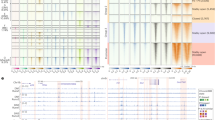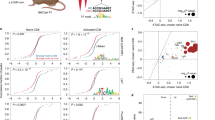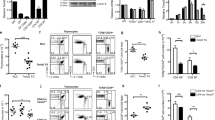Abstract
The molecular mechanisms underlying the differentiation of interleukin 17–producing T helper cells (TH-17 cells) are still poorly understood. Here we show that optimal transcription of the gene encoding interleukin 17 (Il17) required a 2-kilobase promoter and at least one conserved noncoding (enhancer) sequence, CNS-5. Both cis-regulatory elements contained regions that bound the transcription factors RORγt and Runx1. Runx1 influenced TH-17 differentiation by inducing RORγt expression and by binding to and acting together with RORγt during Il17 transcription. However, Runx1 also interacts with the transcription factor Foxp3, and this interaction was necessary for the negative effect of Foxp3 on TH-17 differentiation. Thus, our data support a model in which the differential association of Runx1 with Foxp3 and with RORγt regulates TH-17 differentiation.
This is a preview of subscription content, access via your institution
Access options
Subscribe to this journal
Receive 12 print issues and online access
$209.00 per year
only $17.42 per issue
Buy this article
- Purchase on Springer Link
- Instant access to full article PDF
Prices may be subject to local taxes which are calculated during checkout









Similar content being viewed by others
Change history
14 November 2008
NOTE: In the version of this article initially published, two panels in Figure 9a were horizontally inverted. The error has been corrected in the HTML and PDF versions of the article.
References
Ivanov, I.I. et al. The orphan nuclear receptor RORγt directs the differentiation program of proinflammatory IL-17+ T helper cells. Cell 126, 1121–1133 (2006).
Nakae, S., Nambu, A., Sudo, K. & Iwakura, Y. Suppression of immune induction of collagen-induced arthritis in IL-17-deficient mice. J. Immunol. 171, 6173–6177 (2003).
Komiyama, Y. et al. IL-17 plays an important role in the development of experimental autoimmune encephalomyelitis. J. Immunol. 177, 566–573 (2006).
Wong, C.K. et al. Proinflammatory cytokines (IL-17, IL-6, IL-18 and IL-12) and Th cytokines (IFN-γ, IL-4, IL-10 and IL-13) in patients with allergic asthma. Clin. Exp. Immunol. 125, 177–183 (2001).
Yang, X.O. et al. Molecular antagonism and plasticity of regulatory and inflammatory T cell programs. Immunity 29, 44–56 (2008).
Veldhoen, M., Hocking, R.J., Atkins, C.J., Locksley, R.M. & Stockinger, B. TGFβ in the context of an inflammatory cytokine milieu supports de novo differentiation of IL-17-producing T cells. Immunity 24, 179–189 (2006).
Mangan, P.R. et al. Transforming growth factor-β induces development of the T(H)17 lineage. Nature 441, 231–234 (2006).
Manel, N., Unutmaz, D. & Littman, D.R. The differentiation of human TH-17 cells requires transforming growth factor-β and induction of the nuclear receptor RORγt. Nat. Immunol. 9, 641–649 (2008).
Yang, L. et al. IL-21 and TGF- β are required for differentiation of human T(H)17 cells. Nature 454, 350–352 (2008).
Yang, X.O. et al. T helper 17 lineage differentiation is programmed by orphan nuclear receptors ROR( and RORγ. Immunity 28, 29–39 (2008).
Ansel, K.M. et al. Deletion of a conserved Il4 silencer impairs T helper type 1-mediated immunity. Nat. Immunol. 5, 1251–1259 (2004).
Lee, D.U., Avni, O., Chen, L. & Rao, A. A distal enhancer in the interferon-γ (IFN-γ) locus revealed by genome sequence comparison. J. Biol. Chem. 279, 4802–4810 (2004).
Agarwal, S. & Rao, A. Modulation of chromatin structure regulates cytokine gene expression during T cell differentiation. Immunity 9, 765–775 (1998).
Akimzhanov, A.M., Yang, X.O. & Dong, C. Chromatin remodeling of interleukin-17 (IL-17)-IL-17F cytokine gene locus during inflammatory helper T cell differentiation. J. Biol. Chem. 282, 5969–5972 (2007).
Zhou, L. et al. TGF-β-induced Foxp3 inhibits TH17 cell differentiation by antagonizing RORγt function. Nature 453, 236–240 (2008).
Ono, M. et al. Foxp3 controls regulatory T-cell function by interacting with AML1/Runx1. Nature 446, 685–689 (2007).
Djuretic, I.M. et al. Transcription factors T-bet and Runx3 cooperate to activate Ifng and silence Il4 in T helper type 1 cells. Nat. Immunol. 8, 145–153 (2007).
Solymar, D.C., Agarwal, S., Bassing, C.H., Alt, F.W. & Rao, A. A 3′ enhancer in the IL-4 gene regulates cytokine production by Th2 cells and mast cells. Immunity 17, 41–50 (2002).
Hatton, R.D. et al. A distal conserved sequence element controls Ifng gene expression by T cells and NK cells. Immunity 25, 717–729 (2006).
Ito, Y. Oncogenic potential of the RUNX gene family: 'overview'. Oncogene 23, 4198–4208 (2004).
Ito, Y. & Miyazono, K. RUNX transcription factors as key targets of TGF-β superfamily signaling. Curr. Opin. Genet. Dev. 13, 43–47 (2003).
Ito, Y. RUNX genes in development and cancer: regulation of viral gene expression and the discovery of RUNX family genes. Adv. Cancer Res. 99, 33–76 (2008).
Zhou, L. et al. IL-6 programs TH-17 cell differentiation by promoting sequential engagement of the IL-21 and IL-23 pathways. Nat. Immunol. 8, 967–974 (2007).
Bettelli, E. et al. Reciprocal developmental pathways for the generation of pathogenic effector TH17 and regulatory T cells. Nature 441, 235–238 (2006).
Oestreich, K.J. et al. Regulation of TCRβ gene assembly by a promoter/enhancer holocomplex. Immunity 24, 381–391 (2006).
Xi, H., Schwartz, R., Engel, I., Murre, C. & Kersh, G.J. Interplay between RORγt, Egr3, and E proteins controls proliferation in response to pre-TCR signals. Immunity 24, 813–826 (2006).
Hu, H., Djuretic, I., Sundrud, M.S. & Rao, A. Transcriptional partners in regulatory T cells: Foxp3, Runx and NFAT. Trends Immunol. 28, 329–332 (2007).
Taniuchi, I. & Littman, D.R. Epigenetic gene silencing by Runx proteins. Oncogene 23, 4341–4345 (2004).
Taniuchi, I. et al. Differential requirements for Runx proteins in CD4 repression and epigenetic silencing during T lymphocyte development. Cell 111, 621–633 (2002).
Levanon, D. & Groner, Y. Structure and regulated expression of mammalian RUNX genes. Oncogene 23, 4211–4219 (2004).
Nurieva, R. et al. Essential autocrine regulation by IL-21 in the generation of inflammatory T cells. Nature 448, 480–483 (2007).
Wu, Y. et al. FOXP3 controls regulatory T cell function through cooperation with NFAT. Cell 126, 375–387 (2006).
Prokunina, L. et al. A regulatory polymorphism in PDCD1 is associated with susceptibility to systemic lupus erythematosus in humans. Nat. Genet. 32, 666–669 (2002).
Helms, C. et al. A putative RUNX1 binding site variant between SLC9A3R1 and NAT9 is associated with susceptibility to psoriasis. Nat. Genet. 35, 349–356 (2003).
Tokuhiro, S. et al. An intronic SNP in a RUNX1 binding site of SLC22A4, encoding an organic cation transporter, is associated with rheumatoid arthritis. Nat. Genet. 35, 341–348 (2003).
He, Y.W., Deftos, M.L., Ojala, E.W. & Bevan, M.J. RORγ t, a novel isoform of an orphan receptor, negatively regulates Fas ligand expression and IL-2 production in T cells. Immunity 9, 797–806 (1998).
Zhang, F. & Boothby, M. T helper type 1-specific Brg1 recruitment and remodeling of nucleosomes positioned at the IFN-γ promoter are Stat4 dependent. J. Exp. Med. 203, 1493–1505 (2006).
Acknowledgements
We thank S. Goenka for reading the manuscript and for technical suggestions for the reporter assay; M. Ono (Kyoto University) for Runx1 and Foxp3 expression plasmids; Y. He (Duke University) for the MSCV-hCD2-RORγt plasmid; G.J. Kersh (Emory University) for the Myc-RORγt-GFP plasmid; G.P. Nolan (Stanford University) for Phoenix cells; D.R. Littman (New York University) for monoclonal anti-RORγt; Y. Huang and Z.Y. Hu for technical support in real time PCR experiments; and X.Y. Yan for help with making reporter constructs.
Author information
Authors and Affiliations
Contributions
F.Z. and W.S. designed experiments; F.Z. did all of the experiments and wrote the manuscript; G.M. contributed Supplementary Fig. 3 and was involved in coimmunoprecipitation experiments; and W.S. directed the project and helped to write the manuscript.
Corresponding author
Supplementary information
Supplementary Text and Figures
Supplementary Figures 1–8 and Supplementary Table 1 (PDF 615 kb)
Rights and permissions
About this article
Cite this article
Zhang, F., Meng, G. & Strober, W. Interactions among the transcription factors Runx1, RORγt and Foxp3 regulate the differentiation of interleukin 17–producing T cells. Nat Immunol 9, 1297–1306 (2008). https://doi.org/10.1038/ni.1663
Received:
Accepted:
Published:
Issue Date:
DOI: https://doi.org/10.1038/ni.1663
This article is cited by
-
Targeting NR1D1 in organ injury: challenges and prospects
Military Medical Research (2023)
-
Forkhead box P3 gene polymorphisms predispose to type 2 diabetes and diabetic nephropathy in the Han Chinese populations: a genetic-association and gender-based evaluation study
Hereditas (2023)
-
Runx1 Deficiency Promotes M2 Macrophage Polarization Through Enhancing STAT6 Phosphorylation
Inflammation (2023)
-
Hierarchical regulation of the resting and activated T cell epigenome by major transcription factor families
Nature Immunology (2022)
-
Metabolic regulation and function of T helper cells in neuroinflammation
Seminars in Immunopathology (2022)



